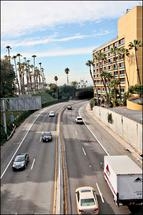
CITY HALL — Today it’s the traffic clogged intersection of the I-10 Freeway and Pacific Coast Highway, but City Hall officials think they can turn it into a green open area that will help revitalize the Civic Center.
City Council is set to approve on Tuesday the first step in an ambitious, multi-year proposal to enclose the I-10 Freeway from Ocean Avenue to Fourth Street and build a park on top.
With an Expo Light Rail stop at Colorado Avenue and Fourth Street scheduled to be built, city officials say the project would enhance walkability by creating a pedestrian friendly connection between the Third Street Promenade, Santa Monica Place and Main Street.
The item before the council authorizes spending $3.47 million to begin studying the project. The amount would pay for a feasibility study and for preliminary engineering work required by the California Department of Transportation.
Community and Strategic Planning Manager Francie Stefan said the feasibility study, which will lay out several options for the project and predict how expensive each would be, costs only about $300,000. The rest of the money would go toward the engineering work.
City Councilman Kevin McKeown has been championing the project since 1999 and said approving the feasibility study will be “the first major step in actually making this happen.”
He said the Expo Light Rail project, which is expected to reach Santa Monica by 2015, has led to a resurgence of interest around the project.
“That freeway is a great separation between the Downtown and the Civic Center we’ve always wanted to heal,” he said. “This in many ways makes Ocean Park a more contiguous part of the city.”
The council has previously expressed support for the project. Approving the money to start work on the plan is considered non-controversial and is part of the council’s consent agenda for its meeting Jan. 19.
The ultimate cost of the project, though, remains unknown.
Once the feasibility study is approved, Los Angeles-based urban design and engineering firm AECOM is expected to present its analysis within three months at a community meeting. The project would then proceed to the Planning Commission and to City Council.
McKeown said he favors keeping the land that would be created over the freeway as public space, but said it’s possible the council could approve land swaps with businesses in the vicinity that would result in some commercial use of the area and money for city coffers.
While he declined to estimate how much the project could cost, he said the newly created land would be worth several hundred dollars per square foot because of it’s desirable location at the city’s core.
“The land we gain is more valuable than the cost of capping the freeway,” he said. “This is one of the all time no brainers.”







